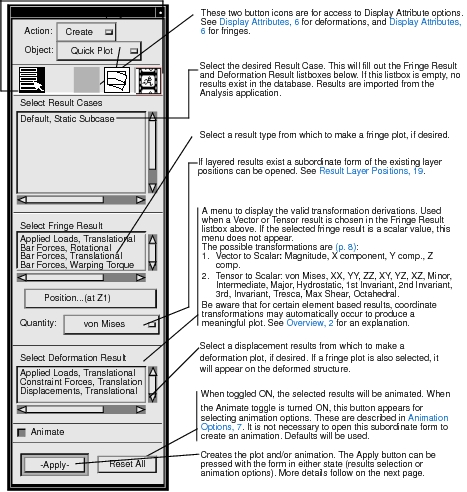XXXXXXXXXXXXXXXXXXXXXXXXXXXXXXXXXXXXXXXXXXXXXXXXXXXXXXXXXXXXXXXXXXXXXXXXXXXXXXXXXXXXXXXXXXXXXXXXXXXXXXXXXXXXXXXXXXXXXXXXXXXXXXXXXXXXXXXXXXXXXXXXXXXXXXXX''"> 3.2 Quick Plot Usage
This is the default form that appears when the Results application is selected. Use this form to plot fringes, deformations and do simple animations.

For more information on the use of these button icons, see the appropriate section.
The derivation of each scalar quantity from either a tensor or vector that is available in the Quick Plot application is described in detail in
Derivations, 8.
It is important to note also that when deriving a scalar quantity for a fringe plot from an element based vector or tensor that results are averaged at the nodes due to the contributions from the surrounding elements. The default is to derive the desired quantity from the tensor or vector quantities (such as von Mises), then to average at the nodes. By default the averaging is done over all entities. This default Averaging Method can be changed with a
settings.pcl parameter. See
Overview, 2.
When multiple layers exist for a specific Result Case and quantity, five additional options are also presented to the user from the Position button. These are Maximum, Minimum, Average, Sum, and Merge. By selecting one of these layers, the minimum, maximum, average, sum or merging of all layers will be calculated for display in the subsequent plot. These plots may be more computationally intensive and take longer to display the final plot due to the results extraction of the maximum, minimum or average for all layers. The results of these derivations are not stored in the database. Use the Create/Results action and object to perform this task. See
Result Layer Positions, 19 for more details.
Fringe plots and deformation plots created from the Quick Plot form are assigned default names that can be seen when the object is changed to Deformation or Fringe or from the Post and Delete forms. These names are default_Deformation and default_Fringe. The Quick Plot form will always operate on these named plots. If more than one viewport is open then the default names are incremented such as default_Deformation2, default_Deformation3, etc.

